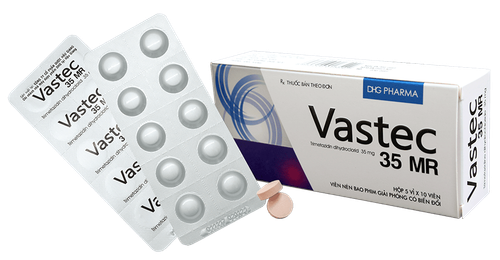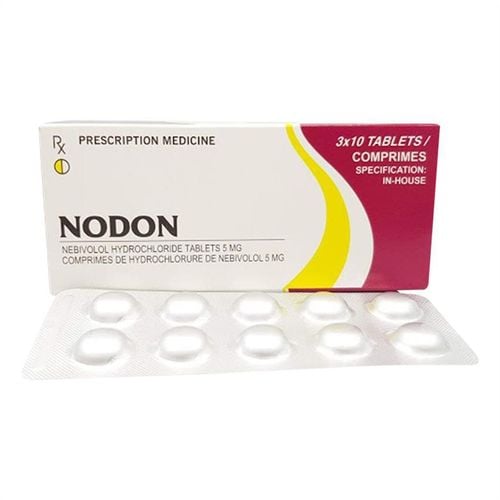This is an automatically translated article.
Iloprost, also known as Iloprost trometamol, is a cardiovascular drug. It is a non-heparin inhibitor of platelet aggregation. To ensure effective use, patients need to strictly follow the instructions of the doctor and medical staff.1. What is Iloprost?
1.1. Pharmacodynamics of Iloprost Iloprost is a synthetic analogue of Prostacyclin. The pharmacological effects that have been studied include:
Restriction of platelet aggregation, adhesion and release. Dilatation of arterioles and venules. Increases density of capillaries and decreases vascular permeability, caused by mediators such as serotonin or histamine in the microcirculation. Stimulates increased endogenous fibrinolysis. The anti-inflammatory effect is through its ability to inhibit the adhesion of white blood cells after endothelial injury and the aggregation of leukocytes in the injured tissue, reducing the release of destructive factors. death of tumors. 1.2. Pharmacokinetics of Iloprost Absorption: Stable serum concentrations are achieved very quickly, after only 10 to 20 minutes from the start of the infusion. Stable serum concentrations of Iloprost have a linear relationship with the infusion rate. Serum concentrations of 135 ± 24 pg/ml are achieved with an infusion rate of 3 mg/kg/min. Serum concentrations of the active ingredient Iloprost decrease rapidly after the end of the infusion and the rate of metabolism is high. The half-life of the terminal metabolite in serum is 0.5 hours. Consequently, the proportion of metabolites decreased to less than 10% of the concentrations achieved at equilibrium only 2 hours after the end of the Iloprost infusion. Distribution: The interaction of Iloprost with other drugs at the plasma protein binding level is uncertain. This is because Iloprost is mainly bound to plasma albumin and the plasma concentrations of iloprost achieved are very low. Metabolism: Iloprost is mainly metabolised via β-oxidation of a carboxyl chain. Unmetabolized substances will not be excreted. Elimination: Metabolism of the drug Iloprost after intravenous infusion, undergoes 2 phases with mean half-lives of 3 - 5 minutes and 15 - 30 minutes. The mean clearance rate of Iloprost is 20 ml/kg/min. The metabolites are eliminated from plasma and urine in two phases with mean plasma half-lives of 2 hours and 5 hours, respectively; and in urine 2 hours and 18 hours.
2. Indications of the drug Iloprost
Iloprost is indicated in the following cases:
Treatment of people with advanced obstructive vasculitis, mainly the vessels of the extremities, for cases where reconstructive surgery cannot be performed. circuit again. Treatment of people with severe peripheral arterial occlusive disease (PAOD), particularly those at high risk for amputation and who cannot undergo orthopedic surgery. Treatment of people with severe Raynaud's syndrome (a vasomotor disorder) that has not responded to other therapies.
3. Usage and dosage of the drug Iloprost
How to use the drug: Dilute, IV infusion or nebulizer.
Dosage of the drug:
IV route:
Dilute, IV infusion for 6 hours/day. The dose is adjusted according to response at a rate of 0.5 to 2 ng iloprost/kg/min. The average duration of treatment is about 4 weeks. Inhalation route:
Dose per inhalation: At the start of treatment, the first inhaled dose is 2.5 micrograms of Iloprost. If this therapeutic dose is well tolerated, the treating physician will increase the dose to 5 micrograms of iloprost and maintain it at that dose. In case of poor tolerance to the dose of 5 micrograms, the therapeutic dose will be reduced to 2.5 micrograms of iloprost.
Daily Dose: Inhalation dose is given 6 to 9 times daily depending on individual need and tolerability.
Other special subjects:
People with Raynaud's syndrome take shorter (3-5 days). People with kidney failure requiring dialysis People with chronic liver disease: reduce the therapeutic dose.
4. Undesirable effects of Iloprost
Common undesirable effects:
Decreased appetite, headache, apathy, confusion. Feelings of dizziness, lightheadedness, false sensations, strong emotions, ringing in the ears, arrhythmia, heart palpitations, confusion, anxiety, lethargy. Occurrence of hot flashes, nausea, vomiting, increased sweating, arrhythmia, bradycardia, angina pectoris, hypotension, increased blood pressure, dyspnea, diarrhea, malaise, abdominal pain and jaw joint pain. Jaw stiffness, muscle pain, joint pain, joint weakness. Body aches, hyperthermia, feeling of heat, fatigue, thirst, injection site reactions such as red rash, soreness or phlebitis. Uncommon side effects:
Thrombocytopenia, hypersensitivity, mental disorders such as depression, hallucinations, convulsions, syncope, tremor, migraine headache, blurred vision, eye swelling, pain eyestrain. Myocardial infarction, heart failure, arrhythmia, extrasystoles. Cerebrovascular accident or ischemic stroke, pulmonary embolism, deep vein thrombosis. Bronchial asthma, pulmonary edema. Diarrhea, haemorrhage, rectal bleeding, dyspepsia, tenesmus, constipation, belching, dysphagia, dry mouth, jaundice, itching. Spasticity of muscles, cramps, increased tone. Renal pain, urogenital tract infection, urinary retention, other urinary tract disorders. Rare adverse effects:
Cough, proctitis or other signs of convulsions.
5. Iloprost drug interactions
When used in combination with the following drugs, will affect the effect of the drug:
Iloprost may increase the effect of antihypertensive drugs and vasodilators. Iloprost should be used with caution with other antihypertensive or vasodilators.
Iloprost platelet inhibitors, used with the following substances may enhance Iloprost-mediated platelet inhibition, thereby increasing the risk of bleeding:
Anticoagulants such as Heparin or anticoagulants used orally (Coumarin) Other platelet aggregation inhibitors, such as acetylsalicylic acid, the analgesic-pyretic group of NSAIDs; Non-selective phosphodiesterase inhibitors such as pentoxifylline; Selective phosphodiesterase 3 (PDE3) inhibitors such as cilostazol or anagrelide, ticlopidine, clopidogrel, glycoprotein IIb/IIIa antagonists, such as abciximab, eptifibatide, tirofiban, defibrotide.
6. Some notes when using Iloprost
6.1. Contraindications Of Iloprost Pregnant women. Women who are breastfeeding. In certain cases, the effect of Iloprost on platelets may increase the risk of bleeding. Severe coronary artery disease or unstable angina. Had a heart attack in the past 6 months. Acute or chronic congestive heart failure (NYHA II-IV). Severe arrhythmia. Suspected pulmonary embolism. Hypersensitivity or hypersensitivity to Iloprost or other components of the drug. 6.2. General Iloprost Elimination of Iloprost is reduced in patients with hepatic impairment, in whom renal failure requires dialysis. For people with low blood pressure, care should be taken to avoid a drop in blood pressure, and people with cardiovascular disease should be closely monitored. Low blood pressure on standing can occur when the user suddenly changes from a lying position to a standing position after just finishing the infusion period. A benefit-risk assessment of treatment should be carried out for those with cerebrovascular disease in the last 3 months. Parenteral infusion of undiluted Iloprost may result in changes at the infusion site. Do not take Iloprost and do not let it come into contact with the mucous membranes. In contact with the skin, Iloprost may cause a painless but long-lasting erythema. Note to pregnant women: Currently, there are not enough data on the use of Iloprost in pregnant women. Preclinical studies have shown that Iloprost has a risk of fetal toxicity in rats but not in rabbits and monkeys. Because the risk of Iloprost treatment in pregnant women is not well known, women of childbearing age should use contraception during treatment with Iloprost. Note to nursing women: It has not been determined whether Iloprost can pass into breast milk. A small amount of Iloprost is excreted in the milk of rats, therefore Iloprost should not be used during lactation. Precautions while driving and using machines: Iloprost has a great influence on the ability to drive and use machines in people who experience symptoms of hypotension such as dizziness. Iloprost, also known as Iloprost trometamol, is a cardiovascular drug. Non-heparin platelet aggregation inhibitor. To ensure effective use, patients need to strictly follow the instructions of the doctor and medical staff. To ensure the effectiveness of treatment and avoid unwanted side effects, patients need to strictly follow the instructions of the doctor, professional pharmacist.
Follow Vinmec International General Hospital website to get more health, nutrition and beauty information to protect the health of yourself and your loved ones in your family.
Please dial HOTLINE for more information or register for an appointment HERE. Download MyVinmec app to make appointments faster and to manage your bookings easily.













